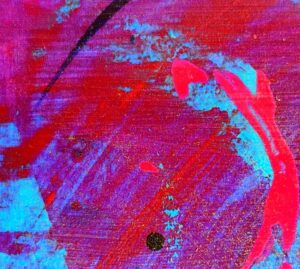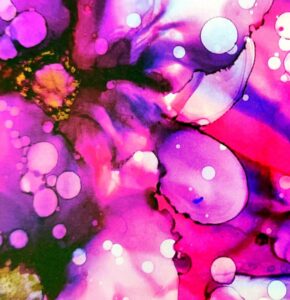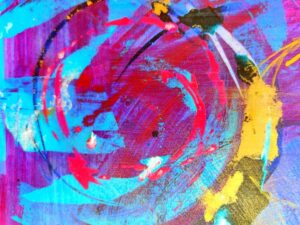In the realm of colour perception, purple is an intriguing phenomenon. Visible light consists of a spectrum of electromagnetic waves, with each wavelength corresponding to a specific colour. Purple falls towards the shorter wavelength end of the spectrum, closer to ultraviolet (UV) light. Unlike other colours that can be created by mixing different wavelengths of light, purple is not a spectral colour and does not have a specific wavelength associated with it.
Our perception of purple arises from a unique combination of red and blue light. When our eyes receive a mix of red and blue light signals, our brain interprets it as purple. The exact mixture of red and blue wavelengths determines the specific shade of purple we perceive. For instance, a higher proportion of red light mixed with blue will result in a warmer, reddish-purple tone, while more blue light will create a cooler, bluish-purple shade.
In terms of human psychology, purple has been found to have a variety of effects on our mood and behaviour. Research suggests that purple can evoke feelings of calmness, creativity, and spirituality. It is often associated with qualities such as wisdom, introspection, and imagination. The colour’s soothing nature can have a relaxing effect on the mind, making it a popular choice for creating serene and tranquil environments.
From a cultural and historical perspective, purple has had significant symbolism and meaning. Ancient societies, such as the Phoenicians* and the Romans, associated purple with royalty, power, and prestige. This association can be traced back to the rarity and costliness of purple dyes, which were derived from scarce sources such as certain shellfish. The use of purple in clothing and regalia became a way to signify social status and authority.
*The name Phoenician, used to describe these people in the first millennium BCE, is a Greek invention, from the word phoinix, possibly signifying the colour purple-red and perhaps an allusion to their production of a highly prized purple dye.
In the natural world, purple appears in various forms. Many flowers, such as lavender, violets, and orchids, display stunning purple petals to attract pollinators. These vibrant hues serve as visual cues for insects and birds, guiding them towards a source of nectar. In addition, certain fruits and vegetables, like grapes and aubergines (eggplants), display shades of purple due to pigments such as anthocyanins, which also provide antioxidant benefits. 
In conclusion, while purple may not have a specific wavelength on the electromagnetic spectrum, it is a captivating colour that arises from a combination of red and blue light. Its psychological effects and cultural symbolism make it a fascinating subject of study. Whether it’s delving into the intricacies of colour perception or exploring the cultural significance of purple throughout history, there is much to uncover about this enchanting hue.
In the vast spectrum of hues that paint our world, one colour stands out with its undeniable allure and mystique. That colour is purple. Radiant and regal, purple has captivated hearts and minds for centuries, invoking a sense of wonder and enchantment. It is a colour that embodies both tranquillity and grandeur, casting a spell upon those who dare to immerse themselves in its velvety embrace.
Purple, born of the delicate dance between the fiery passion of red and the serene tranquillity of blue, harmonises opposing forces and transcends their boundaries. It exists as a bridge between the realms of warmth and coolness, evoking a unique balance that is both captivating and comforting. From the deepest amethysts to the gentlest lilacs, purple manifests in a myriad of shades, each carrying its own distinct personality and allure.
Throughout history, purple has been associated with nobility, spirituality and creativity. In ancient times, the dye used to create this majestic hue was a rare and precious commodity, derived from the secretions of molluscs. Such scarcity made purple garments a symbol of power and prestige, reserved only for kings, queens, and others of noble birth. It was a colour that commanded respect and awe, reflecting the majesty and authority of those who wore it.
Yet, purple’s significance extends beyond earthly realms. It possesses an ethereal quality, beckoning us to explore the realms of the imagination and spirituality. In the vast expanse of the cosmos, the twilight skies reveal a majestic tapestry of purple hues as day gives way to night. This celestial spectacle stirs the soul, inviting contemplation and connection with the mysteries of the universe.
The colour purple also possesses an intimate relationship with art and creativity. From the delicate strokes of an Impressionist painting to the bold expressions of abstract masterpieces, purple serves as an essential tool in the artist’s palette. It adds depth and intrigue to compositions, infusing them with a touch of otherworldly charm. Purple is the colour of inspiration, whispering secrets to artists and encouraging them to embark on journeys of self-expression.

In the realm of emotions, purple carries a serene energy that fosters introspection and introspection. It is a colour that soothes the soul, providing a refuge from the chaos and noise of the world. In moments of quiet solitude, surrounded by shades of lavender or plum, purple envelops us with a sense of peace and reflection, encouraging us to reconnect with our inner selves.
Purple’s symbolic richness extends into the tapestry of human existence. It represents the fusion of polarities, reminding us that harmony can arise from diversity. It encourages us to embrace our uniqueness, to celebrate the vivid hues that colour our lives. Purple is a reminder that life’s true beauty lies in the kaleidoscope of experiences, perspectives, and identities that we bring together.
So, the next time you encounter a blooming lavender field, glimpse a majestic amethyst gem, or catch a glimpse of the twilight sky ablaze in purple hues, take a moment to pause and immerse yourself in the magic of this enchanting colour. Allow it to transport you to a realm where dreams are woven, where the mundane is transformed into the extraordinary. For purple is not merely a colour; it is a symphony of enchantment that resonates within our hearts and ignites our imagination.
On a personal level purple is one of the colours I really enjoy working with. I do this by using turquoise and pink which, when mixed together, create a fabulous purple which often appears in my work.
If you have enjoyed reading this post, please like and follow me and share it with people who you think might be interested. I am always looking for new artists to feature and if there is a subject you would like me to write about, I will be happy to consider it. Sharing, liking and following my blogs increases the number of people the algorithm shows them to. If you check out my website you can see my class bookings are now online too.
Thank you in advance for supporting me this way.

1 Comment.
Very informative! I’ve learnt a lot about the colour purple.